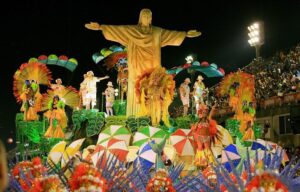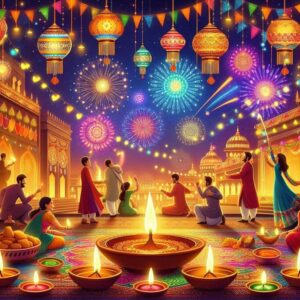
Kavindya Senevirathna
Celebrating the Colors of Humanity: The World’s Most Iconic Cultural Festivals
Culture can be considered one of the fundamental principles of human life. It encompasses the behavior, beliefs, religion, art, food, and lifestyle of the people of a nation. Each country preserves its own unique set of values and traditions, often expressed through its festivals.
Festivals act as a unifying force within societies. They share happiness, strengthen bonds among communities, and preserve cultural heritage rich with meaning. While many festivals across the world have religious roots, others are purely dedicated to fun, laughter, and the joy of living.
Our world forms a vast and diverse cultural landscape. Among its most vibrant expressions are festivals that not only reflect a nation’s heritage but also the life, love, and passion of its people. These celebrations carry deep cultural significance and showcase the shared spirit of humanity.
1. Rio Carnival – Brazil’s Lively Festival of Music and Dance

Location: Rio de Janeiro, Brazil
Date: February (before Lent)
The Rio Carnival is considered the largest and most exhilarating festival in the world. It is an annual spectacle that unites music, dance, and dazzling artistry to embody the spirit and energy of the Brazilian people.
Even its opening atmosphere can fill anyone’s heart with excitement. Massive parades fill the streets as Samba Schools compete, each performing with its own creative theme, colorful floats, lively bands, and stunning costumes.
Rio Carnival is pure joy in motion. The rhythm of samba; Brazil’s national dance has become a symbol of the country’s cultural identity and gained worldwide fame. During the festival, the city of Rio truly never sleeps; music, dance, and celebration continue long into the night.
This festival allows Brazilians to express their freedom, vitality, and love of life. Though it is a celebration of joy, it also carries a cultural and religious foundation — originally marking the period of festivity before the Catholic Lent season.
2. Diwali – India’s Festival of Light Conquering Darkness

Location: India, Nepal, Sri Lanka, and Indian Communities Worldwide
Duration: October – November
Diwali, known as the “Festival of Lights,” is one of the most sacred and beloved celebrations in India. Rooted in Hindu tradition, it symbolizes the victory of Lord Rama over darkness and the triumph of good over evil.
The festival marks new beginnings and emphasizes cleanliness, renewal, and light in every household. Homes are thoroughly cleaned and beautifully decorated with diyas (oil lamps) and colorful lights. Shades of red, orange, and magenta fill the night sky, creating a dazzling festive ambiance.
For both children and adults, Diwali is a time for sharing love, exchanging gifts, and reconnecting with friends and family. The celebration is enriched with traditional sweets and delicacies such as Ladu, Jalebi, Gulab Jamun, and a variety of savory dishes that bring families together.
Diwali is not only a celebration of joy but also a symbol of moral triumph. It represents humanity’s eternal hope for goodness and light to overcome darkness. As such, Diwali stands as a festival of peace, compassion, and universal inspiration.
3. Chinese New Year – A Celebration of Family and Renewal

Location: China, Hong Kong, Taiwan, and Chinese Communities Around the World
Date: Late January – Early February
The Chinese New Year, also known as the “Spring Festival,” is the most significant and cherished event in Chinese culture. It represents renewal, unity, and the enduring value of family togetherness.
The celebration begins on New Year’s Day according to the traditional lunar calendar. Days before the festival, people clean their homes to sweep away bad luck and prepare special meals. A cherished custom is giving “red envelopes” (Hongbao) containing money to children and newborns as a symbol of blessings and prosperity.
Across cities, colorful parades, dragon and lion dances, and red temple decorations create a magnificent display. The highlight of the celebration is the “Reunion Dinner,” where families gather around a large feast to honor unity and love.
Each year of the Chinese New Year corresponds to one of the zodiac animals; such as the horse, tiger, rooster, or ox representing values that guide the year’s spirit. Through this vibrant festival, Chinese people across the world maintain a profound connection to their roots and traditions.
4. La Tomatina – Spain’s Funniest Tomato Festival

Location: Buñol, Valencia, Spain
Date: End of August
La Tomatina is widely known as one of the most entertaining and lighthearted festivals on Earth. The highlight of this festival is an epic tomato fight, where thousands of participants gather in the city center to joyfully throw tomatoes at one another for about an hour.
The festival’s origins date back to 1945, when a playful food fight among local teenagers led to the creation of this unique tradition. Over time, the town of Buñol transformed it into a world-famous celebration.
La Tomatina brings people together regardless of language, nationality, or social status. It is a symbol of joy, togetherness, and shared laughter. At the end of the event, the streets are thoroughly cleaned — a fitting reflection of the festival’s cheerful and inclusive spirit.
5. Oktoberfest – Germany’s Iconic Festival of Beer and Music

Location: Munich, Germany
Duration: Late September to mid-October
Oktoberfest is celebrated as the world’s largest beer festival and one of Germany’s most iconic cultural events. Originating in 1810 as a royal wedding celebration for the Bavarian crown prince, it has evolved into a global phenomenon attracting millions of visitors each year.
During Oktoberfest, massive beer tents are set up across Munich, where traditional German beer is served alongside regional dishes such as sausages, pretzels, and roasted meats. The lively atmosphere is further enhanced by folk music, dancing, and traditional costumes like lederhosen and dirndls.
Beyond the merriment, Oktoberfest reflects the sociable and welcoming nature of German culture. It brings together families, friends, and tourists in a spirit of unity and festivity. Due to its popularity, similar Oktoberfest celebrations are now held in many countries around the world.
The Shared Spirit of Celebration
The diversity of the world’s cultural festivals reveals the beauty and resilience of the human spirit. Every festival carries its own rhythm, color, and meaning; no two are ever the same.
Rio Carnival embodies music and pure joy. Diwali illuminates’ hearts with light and hope. Chinese New Year celebrates family unity and renewal. La Tomatina spreads laughter through playful chaos. Oktoberfest unites people through camaraderie and cheer.
Though these festivals differ in origin and tradition, they all express the same universal truth — the inner joy of humanity, the warmth of connection, and the importance of cultural respect. In a world of diversity, festivals remind us that joy and togetherness are the greatest bridges between people.